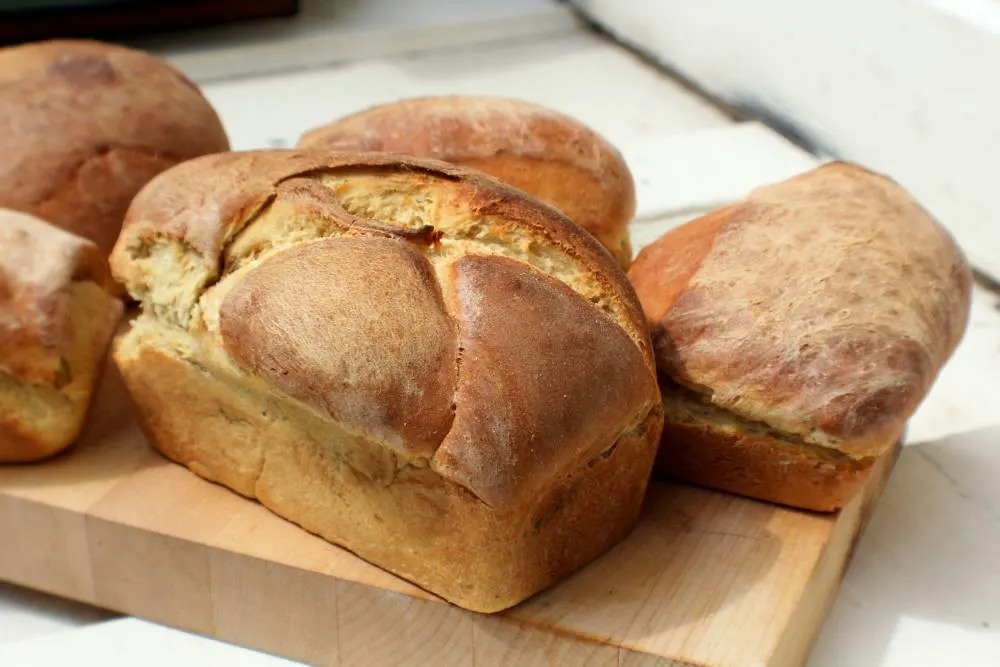
Isn’t it frustrating when store-bought sandwich bread just doesn’t measure up? It’s either too sweet, falls apart mid-sandwich, or lacks that robust flavor we crave. The solution? Sourdough sandwich bread—a homemade, delicious option that’s healthier, tastier, and customizable to your needs.
Let’s break it all down: why sourdough sandwich bread is your bread-lover’s dream, how to perfect your own loaf, and secret tips to elevate your bread-baking game.
TL;DR
- Sourdough sandwich bread combines the tangy flavor of sourdough with a soft, fluffy texture perfect for sandwiches.
- It’s healthier and easier to digest than commercial bread, thanks to natural fermentation.
- Use a mix of bread flour and whole wheat flour for a balance of strength and flavor.
- Don’t rush! A slow fermentation process is key to flavor and texture.
- Get creative—try adding seeds, herbs, or honey for a personalized touch.
Why Sourdough Sandwich Bread is a Game-Changer
Health Benefits You Can Feel
Forget ultra-processed loaves filled with preservatives. Sourdough bread undergoes natural fermentation, making it easier to digest. The lactic acid bacteria in sourdough break down gluten and enhance nutrient availability, making it a win for gut health.
Flavor That Speaks for Itself
Sourdough sandwich bread offers a slightly tangy, rich flavor that perfectly complements any sandwich filling. From peanut butter and jelly to a turkey club, the subtle sourdough undertones elevate every bite.
Perfect Texture for Sandwich Lovers
Commercial sourdough can sometimes feel too crusty for sandwiches. Homemade sourdough sandwich bread, however, strikes the perfect balance: a soft, tender crumb with just the right chew to hold up to spreads, toppings, and sauces without getting soggy.
Step-by-Step Guide to Baking Sourdough Sandwich Bread
1. Choosing the Right Ingredients
- Flour: Use high-protein bread flour for structure and softness. A mix of bread flour and whole wheat flour is a great choice for added flavor and nutrition.
- Sourdough Starter: Ensure your starter is active and bubbly. Feed it 6–8 hours before starting to bake.
- Water: Use filtered water to avoid any chemicals that could harm your starter.
- Salt: Don’t skip this! Salt enhances flavor and controls fermentation.
2. Mix and Autolyze
- Combine your flour and water, mixing until just combined.
- Let the dough rest (autolyze) for 30 minutes to an hour. This step allows the flour to hydrate and gluten to develop naturally, leading to a softer, more elastic dough.
3. Incorporate the Starter and Salt
Add your active sourdough starter and salt. Mix thoroughly but gently. Overworking the dough at this stage can compromise the crumb structure.
Pro Tips for Success
Secret #1: Master the Bulk Fermentation
Bulk fermentation is where the magic happens.
- Let your dough rest in a warm environment (75°F–80°F is ideal) for 4–6 hours.
- Perform a series of “stretch and folds” every 30 minutes for the first 2 hours. This strengthens the dough and evenly distributes the starter.
Secret #2: Patience in the Proofing Stage
Once shaped into a loaf and placed in a pan, proofing takes time. For sourdough sandwich bread, a final proof in the fridge overnight is ideal. This slows down fermentation, enhancing flavor and making the dough easier to handle.
Baking the Perfect Sourdough Sandwich Bread
- Preheat Your Oven: Heat it to 375°F for a softer crust. For a golden crust, you can go up to 400°F.
- Steam It Up: Place a tray of water in the oven or lightly spritz the dough with water to create steam. This helps the bread expand and achieve a soft crust.
- Bake Time: Bake for 35–40 minutes. Rotate the pan halfway through for even baking.
Personalize Your Sourdough Sandwich Bread
Add Flavors
- A tablespoon of honey adds natural sweetness.
- Mix in sesame seeds, flaxseeds, or poppy seeds for a nutty texture.
Texture Tweaks
- Want an even softer crust? Brush the loaf with melted butter right after it comes out of the oven.
- Prefer a chewier crumb? Extend the autolyze time or use more bread flour.
Common Challenges (and How to Fix Them)
1. Dense or Heavy Loaf
Cause: Underproofing or low hydration.
Solution: Allow more time for proofing and ensure your dough isn’t too dry.
2. Gummy Texture
Cause: Cutting the bread too early.
Solution: Let the bread cool completely before slicing—it needs time to set.
3. Collapsing During Proofing
Cause: Overproofing.
Solution: Keep an eye on your dough during the second rise. If it feels too airy, it’s time to bake.

Classic Sourdough Sandwich Bread Recipe
Ingredients:
- 500g bread flour
- 100g active sourdough starter (100% hydration)
- 300ml water (lukewarm)
- 8g salt
- 20g sugar (optional, for a slightly sweeter loaf)
- 30g unsalted butter (softened)
Instructions:
1. Feed Your Starter
- Feed your sourdough starter 6–8 hours before beginning. Ensure it’s active and bubbly.
2. Autolyze the Dough
- In a large mixing bowl, combine the bread flour and water. Mix until just combined. Cover and let it rest for 30–60 minutes.
3. Mix in Starter and Salt
- Add the sourdough starter and salt to the dough. Mix well until fully incorporated. If using sugar and butter, mix them in now.
4. Bulk Fermentation
- Let the dough rest in a warm spot for 4–5 hours, performing stretch-and-folds every 30 minutes for the first 2 hours. This builds structure and distributes the starter evenly.
5. Shape the Dough
- Lightly flour a surface, then shape the dough into a rectangle. Roll it tightly into a log and place it seam-side down in a greased loaf pan.
6. Final Proof
- Cover the dough with a damp cloth or plastic wrap and let it proof for 3–4 hours at room temperature or overnight in the fridge.
7. Bake the Bread
- Preheat your oven to 375°F (190°C). Bake for 35–40 minutes, or until the crust is golden and the loaf sounds hollow when tapped on the bottom.
- Optional: Brush with melted butter for a softer crust.
8. Cool and Slice
- Allow the bread to cool completely before slicing to prevent a gummy texture.
Whole Wheat Sourdough Sandwich Bread Recipe
Ingredients:
- 300g bread flour
- 200g whole wheat flour
- 100g active sourdough starter (100% hydration)
- 330ml water (lukewarm)
- 10g salt
- 15g honey or maple syrup
- 20g olive oil or melted butter
Instructions:
1. Feed Your Starter
- Ensure your sourdough starter is active and bubbly before starting.
2. Autolyze the Dough
- Mix the bread flour, whole wheat flour, and water in a large bowl until combined. Let it rest for 30–60 minutes.
3. Incorporate Starter, Salt, and Sweetener
- Add the sourdough starter, salt, and honey to the autolyzed dough. Mix well to combine.
4. Bulk Fermentation
- Rest the dough for 4–5 hours at room temperature. Perform 3–4 sets of stretch-and-folds during the first 2 hours to build elasticity.
5. Add Olive Oil
- During the last stretch-and-fold, drizzle olive oil onto the dough and gently fold it in. This step gives the bread a tender crumb.
6. Shape the Dough
- On a floured surface, shape the dough into a loaf. Place it in a greased loaf pan, seam-side down.
7. Final Proof
- Proof for 3–4 hours at room temperature or overnight in the refrigerator.
8. Bake the Bread
- Preheat your oven to 375°F (190°C). Bake the bread for 35–40 minutes. For a chewier crust, bake at 400°F for the first 10 minutes, then lower the temperature.
9. Cool and Enjoy
- Allow the bread to cool completely before slicing. This loaf pairs beautifully with savory fillings like turkey or a simple avocado spread.
Tips for Both Recipes:
- Use filtered water for best results.
- Adjust hydration slightly if using different flours, as whole wheat absorbs more water.
- Store loaves in a bread bag or wrapped in a tea towel to maintain freshness.
Enjoy these recipes to create soft, tangy loaves perfect for sandwiches! 🥪
Conclusion
Homemade sourdough sandwich bread is worth every minute of effort. With a soft, airy crumb and a mild tang, it’s the perfect upgrade to your sandwich game. By mastering the basics and embracing your creativity, you’ll never settle for store-bought again. So, preheat that oven and let the aroma of freshly baked bread fill your kitchen—your taste buds will thank you!
FAQs
What makes sourdough sandwich bread different from regular sourdough?
Sourdough sandwich bread is softer and less crusty, making it ideal for sandwiches.
Can I make sourdough sandwich bread gluten-free?
Yes, with a gluten-free sourdough starter and the right blend of gluten-free flours.
Why is my sourdough bread dense?
Underproofing or insufficient hydration could be the culprits. Give it more rise time or adjust water content.
How long does sourdough sandwich bread last?
Properly stored in an airtight container, it stays fresh for 3–5 days.
What’s the best way to store sourdough sandwich bread?
Wrap it in a clean tea towel or keep it in a bread box to maintain its texture.
Can I freeze sourdough sandwich bread?
Absolutely! Slice it first and store it in a freezer-safe bag for easy thawing.
Why does my crust turn too hard?
Baking at a lower temperature (375°F) and brushing with butter can help.
Is sourdough bread healthier than commercial bread?
Yes! The fermentation process makes it easier to digest and more nutritious.
Can I use all-purpose flour instead of bread flour?
Yes, but bread flour yields better structure and chew.
Do I need special equipment to bake sourdough sandwich bread?
Not necessarily. A loaf pan and an oven are all you need for great results.
Join Us and Transform >
Don’t Be an Amateur! Master the Art of Sourdough Bread!




Leave a comment